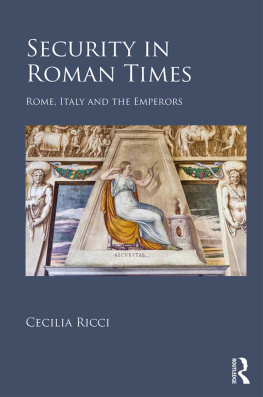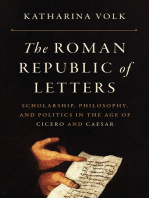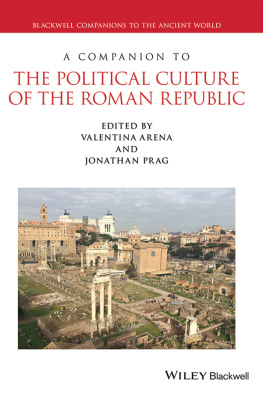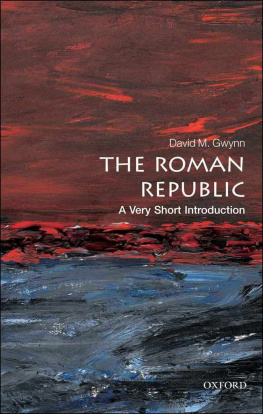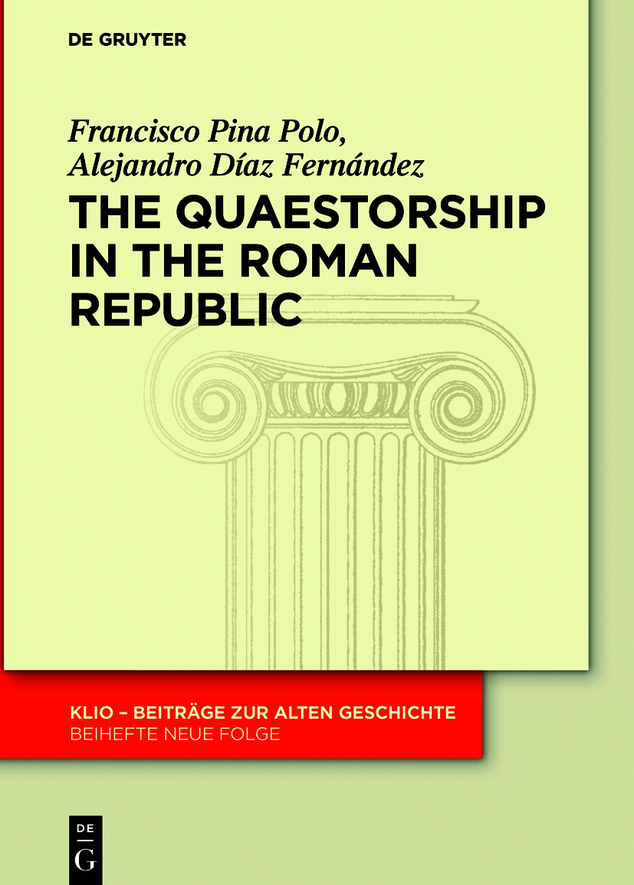Francisco Pina Polo, Alejandro Daz Fernndez
The Quaestorship in the Roman Republic
KLIO / Beihefte. Neue Folge
Beitrge zur Alten Geschichte
Edited by
Hartwin Brandt
Manfred Clauss
Martin Jehne
Peter Funke
Hans-Joachim Gehrke
Volume
Francisco Pina Polo, Alejandro Daz Fernndez
The Quaestorship in the Roman Republic
ISBN 9783110663419
e-ISBN (PDF) 9783110666410
e-ISBN (EPUB) 9783110663747
Bibliographic information published by the Deutsche Nationalbibliothek
The Deutsche Nationalbibliothek lists this publication in the Deutsche Nationalbibliografie; detailed bibliographic data are available on the Internet at http://dnb.dnb.de.
2019 Walter de Gruyter GmbH, Berlin/Boston
To Romana, as always and forever.
Someone like you makes it all worthwhile
Someone exactly like you
To Marina, Julia and Mara Jess,
for their unconditional support,
infinite patience and daily love
Preface
This book is the fruit of the project The quaestorship during the Republic at Rome and abroad, sponsored by the Spanish Ministerio de Economa y Competitividad (HAR2013-43477-P).
The authors are very grateful to some individuals and institutions that have helped make this project a reality. Each author would like to express his gratitude separately.
Francisco Pina Polo took the first steps in researching the elusive quaestors in 2014, when he spent three months at Princetons Institute for Advanced Study and enjoyed not only the wonderful atmosphere but also a place in its beautiful library overlooking the pond and woods. In 2015 and 2016, I was a guest for some weeks first at the Seminar fr Alte Geschichte of Mnster and then at the Institut fr Geschichte (Lehrstuhl fr Alte Geschichte) of Dresden, which are directed by two good friends and excellent colleagues, Johannes Hahn and Martin Jehne, respectively. Their hospitality and joviality truly helped me advance this project. Last but not least, in 2017 I had the privilege of being a Visiting Research Fellow at Merton College during Trinity term. Anyone who has ever spent some time working in the Sackler and Bodleian Libraries knows very well what this means for an ancient historian: paradise. For this privilege I am very much indebted to Jonathan Prag, Professor of Ancient History in Merton and himself a great expert on the Roman quaestorship. I would also like to thank other Oxonian colleagues who generously discussed some aspects of this book with me, including Fergus Millar and Henriette van der Blom (now in Birmingham). Some colleagues, including Werner Eck and Anne Kolb, have given their advice on various questions or have provided useful bibliographical items, for which I am very grateful. I owe a very special debt of gratitude to my colleague and friend Cristina Rosillo-Lpez (University Pablo de Olavide, Seville), since she has patiently read substantial parts of the book and has always contributed invaluable advice and recommendations that have improved it. Needless to say, none of these colleagues and friends can be blamed for any infelicities or mistakes in the book.
Alejandro Daz Fernndez continued the work initiated by Francisco Pina Polo during two successive research trips in Rome (2016 and 2017) that were financed by the University of Mlaga with the invaluable help of the Escuela Espaola de Historia y Arqueologa of Rome (EEHAR-CSIC). I am sincerely grateful to Emma Chesterman for the translation and improvement of my text, as well as to my colleagues in the Department of Historical Sciences of the University of Mlaga, my dear friend Francho and my family for their support and unconditional patience: completing this project would indeed have been impossible without the kind collaboration of so many people and institutions.
Finally, we want to thank Benjamin Jerue for the complete revision of the text and stylistic improvement.
Introduction
Some years ago in a paper in which he re-examined the quaestorship during the third and second centuries,
Two German dissertations on the Roman quaestorship were written at the end of the nineteenth century and the beginning of the twentieth, respectively. To date, they are the only monographs that take the quaestorship as their main subject. Both dissertations, however, had a limited scope, since they were dedicated exclusively to assembling the prosopography of the Republican quaestors. In Chemnitz in 1893 Martin Blz wrote his dissertation about the provincial quaestors between 82 and 44. In his book he ordered the quaestors chronologically, province by province. Some years later, in 1908, Blz complemented his dissertation with a booklet entitled Fasti Quaestorum, in which he not only collected the quaestors between 414 and 83, but also amassed the ancient sources that provide evidence about the office. Friedrich Sobeck wrote his dissertation under the supervision of Conrad Cichorius in 1909. Although his work was intended primarily as a prosopography of the Roman quaestors, his objective was more ambitious than that of Blz: Sobeck listed all the quaestors from the beginning of the Republic until 44, both those who performed their office in a province and those who stayed at Rome. Sobeck gathered the ancient sources for each magistrate along with any known details about each individual. His prosopography later served as one of the bases for Broughtons The Magistrates of the Roman Republic, which still remains the standard reference work on Republican prosopography.
Until now, Theodor Mommsens nineteenth-century Rmisches Staatsrecht provided the most comprehensive analysis of the quaestorship. As is often the case for those working on the Roman constitution, the shadow of Mommsen has continued to dominate the debate for better or for worse. Indeed, Mommsen has proven so influential that subsequent debates about the quaestorship sometimes appear to have beenor perhaps still arelittle more than disputes among supporters and detractors of Mommsens arguments, particularly with regard to subjects such as the origin of the quaestorship and its apparent relationship to the quaestores parricidii, the so-called Italian quaestorships, the place of the quaestorship in the development of the cursus honorum and the possible existence of a minimum age for holding the office.
In the context of more general reference works, only a few scholars have attempted to provide a global picture of the history and functions of the quaestorship. In his article on the quaestorship for the Real-Encyclopdie Pauly-Wissowa published in 1963, Wesener followed Mommsens theses point-by-point. Kunkel and Wittmann did not go much further in 1995 in an article that adhered to the overly formalistic and legalistic framework inherited from Mommsen. At any rate, Kunkel and Wittmann did incorporate some of the new ideasand questionsthat had been generated during the debates of the twentieth century. Both Lintott in his 1999 book The Constitution of the Roman Republic and Covino in a 2013 article on quaestors for The Encyclopedia of Ancient History dealt very briefly with the office and merely summarised some of the well-known problems. In a 2014 article published in Klio, Muiz Coello made the most recent attempt to analyse comprehensively the origin, history and function of the quaestorship, which unfortunately did not offer any answers to the main questions engulfing the office; furthermore, in some cases this article actually reverted to obsolete positions.


